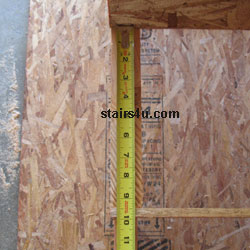Measurement Tolerance - Stairs And Building Codes
Measurement tolerance are usually dictated by building codes. For example, each stair riser isn't allowed to have more than 3/8 of an inch difference in height, throughout the entire stairway. The picture below provides you with an example of someone checking an individual stair tread, for inconsistencies.

There are plenty of building measurement tolerances,
through out the home building and construction industry. There are
minimums and maximums for almost every type of building materials and
their installation.
Public buildings like shopping malls usually have stricter measurement
tolerances than a residential home. You might have five people that
occupy a house, for most of the year. Throughout the rest of the year,
you could end up with a view more people visiting your house.
In a shopping mall, you might have a thousand people walk through an
individual store in just one day. The amount of traffic in a building,
usually creates tougher building codes with stricter measurement
tolerances.
The odds of someone tripping over a doorway threshold that's 1 inch high
in your house, might not be very high. However, put a 1 inch high
threshold in a shopping mall doorway, where 1000 people are entering and
exiting each day and you've just increased your chances of someone
tripping or injuring themselves.
Building measurement tolerance and codes were created to protect the
building occupants from things that most of us don't even think about
each day.
Stairs / Stair Glossary
A B C D E F G H I J K L M N O P Q R S T U V W X Y Z


